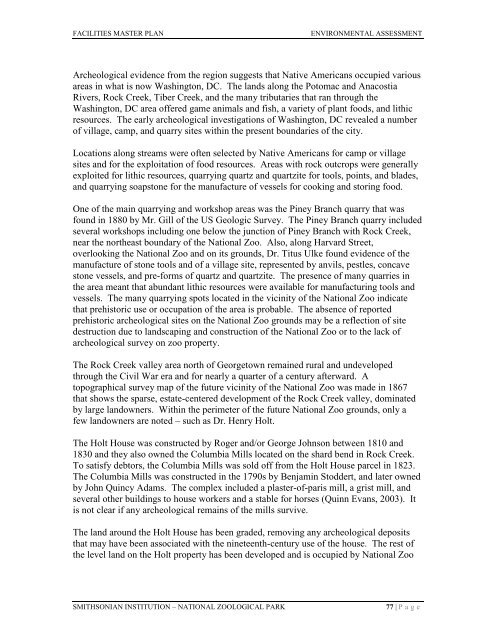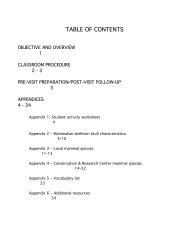facilities renewal master plan - National Zoo - Smithsonian Institution
facilities renewal master plan - National Zoo - Smithsonian Institution
facilities renewal master plan - National Zoo - Smithsonian Institution
You also want an ePaper? Increase the reach of your titles
YUMPU automatically turns print PDFs into web optimized ePapers that Google loves.
FACILITIES MASTER PLAN ENVIRONMENTAL ASSESSMENT<br />
Archeological evidence from the region suggests that Native Americans occupied various<br />
areas in what is now Washington, DC. The lands along the Potomac and Anacostia<br />
Rivers, Rock Creek, Tiber Creek, and the many tributaries that ran through the<br />
Washington, DC area offered game animals and fish, a variety of <strong>plan</strong>t foods, and lithic<br />
resources. The early archeological investigations of Washington, DC revealed a number<br />
of village, camp, and quarry sites within the present boundaries of the city.<br />
Locations along streams were often selected by Native Americans for camp or village<br />
sites and for the exploitation of food resources. Areas with rock outcrops were generally<br />
exploited for lithic resources, quarrying quartz and quartzite for tools, points, and blades,<br />
and quarrying soapstone for the manufacture of vessels for cooking and storing food.<br />
One of the main quarrying and workshop areas was the Piney Branch quarry that was<br />
found in 1880 by Mr. Gill of the US Geologic Survey. The Piney Branch quarry included<br />
several workshops including one below the junction of Piney Branch with Rock Creek,<br />
near the northeast boundary of the <strong>National</strong> <strong>Zoo</strong>. Also, along Harvard Street,<br />
overlooking the <strong>National</strong> <strong>Zoo</strong> and on its grounds, Dr. Titus Ulke found evidence of the<br />
manufacture of stone tools and of a village site, represented by anvils, pestles, concave<br />
stone vessels, and pre-forms of quartz and quartzite. The presence of many quarries in<br />
the area meant that abundant lithic resources were available for manufacturing tools and<br />
vessels. The many quarrying spots located in the vicinity of the <strong>National</strong> <strong>Zoo</strong> indicate<br />
that prehistoric use or occupation of the area is probable. The absence of reported<br />
prehistoric archeological sites on the <strong>National</strong> <strong>Zoo</strong> grounds may be a reflection of site<br />
destruction due to landscaping and construction of the <strong>National</strong> <strong>Zoo</strong> or to the lack of<br />
archeological survey on zoo property.<br />
The Rock Creek valley area north of Georgetown remained rural and undeveloped<br />
through the Civil War era and for nearly a quarter of a century afterward. A<br />
topographical survey map of the future vicinity of the <strong>National</strong> <strong>Zoo</strong> was made in 1867<br />
that shows the sparse, estate-centered development of the Rock Creek valley, dominated<br />
by large landowners. Within the perimeter of the future <strong>National</strong> <strong>Zoo</strong> grounds, only a<br />
few landowners are noted – such as Dr. Henry Holt.<br />
The Holt House was constructed by Roger and/or George Johnson between 1810 and<br />
1830 and they also owned the Columbia Mills located on the shard bend in Rock Creek.<br />
To satisfy debtors, the Columbia Mills was sold off from the Holt House parcel in 1823.<br />
The Columbia Mills was constructed in the 1790s by Benjamin Stoddert, and later owned<br />
by John Quincy Adams. The complex included a plaster-of-paris mill, a grist mill, and<br />
several other buildings to house workers and a stable for horses (Quinn Evans, 2003). It<br />
is not clear if any archeological remains of the mills survive.<br />
The land around the Holt House has been graded, removing any archeological deposits<br />
that may have been associated with the nineteenth-century use of the house. The rest of<br />
the level land on the Holt property has been developed and is occupied by <strong>National</strong> <strong>Zoo</strong><br />
SMITHSONIAN INSTITUTION – NATIONAL ZOOLOGICAL PARK 77 | P a g e

















